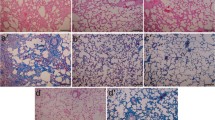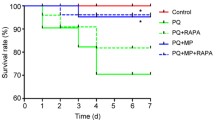Abstract
Pirfenidone is known to slow the decline in vital capacity and increase survival in idiopathic pulmonary fibrosis (IPF). Besides, administration of glucocorticoids, e.g., prednisolone has been the conventional strategy to the treatment of patients with this disease, although their efficacy is under debate. Since multiple coactivated pathways are involved in the pathogenesis of IPF, combination therapy is a foundation strategy to cover many more synergetic mechanisms and increase response. The aim of the present study was to compare the therapeutic efficacy of prednisolone plus pirfenidone with pirfenidone alone in PQ-induced lung fibrosis. After development of PQ-induced lung fibrosis, pirfenidone, prednisolone, and their combination were administered for 14 consecutive days. Lung pathological lesions, along with increased hydroxyproline were determined in the paraquat group. Paraquat also caused oxidative stress and increasing the proinflammatory and profibrotic gene expression. Pirfenidone attenuated the PQ-induced pulmonary fibrosis from the analysis of antioxidant enzymes but prednisolone had no such effect. Co-treatment with pirfenidone and prednisolone suppressed lung hydroxyproline content, TGF-β1, and TNF-α; however, prednisolone alone could not suppress pulmonary fibrosis which was significantly suppressed only by pirfenidone. Pirfenidone also suppressed the increase in MMP-2 and TIMP-1 induced by PQ. All of these effects were exaggerated when pirfenidone coadministered with prednisolone. These findings suggest that pirfenidone exerts its antifibrotic effect through regulation of hydroxyproline content, oxidative stress and proinflammatory and profibrotic gene expression during the development of PQ-induced pulmonary fibrosis in rats and combination therapy with prednisolone can represent more potent therapeutic effects.



Similar content being viewed by others
Change history
15 November 2017
Unfortunately, the original publication of this article contained mistakes, and the authors would like to correct them. The corrected details are given below:
Abbreviations
- CAT:
-
Catalase
- IPF:
-
Idiopathic pulmonary fibrosis
- MDA:
-
Malondialdehyde
- MMP-2:
-
Matrix metalloproteinase-2
- PF:
-
Pirfenidone
- PQ:
-
Paraquat
- PR:
-
Prednisolone
- SOD:
-
Superoxide dismutase
- TGF-β:
-
Transforming growth factor beta
- TIMP-1:
-
Tissue inhibitor of metalloproteinase-1
- TNF-α:
-
Tumor necrosis factor alpha
References
Wuyts, W.A., K.M. Antoniou, K. Borensztajn, U. Costabel, V. Cottin, B. Crestani, J.C. Grutters, T.M. Maher, V. Poletti, and L. Richeldi. 2014. Combination therapy: the future of management for idiopathic pulmonary fibrosis? The Lancet Respiratory Medicine 2: 933–942.
Raghu, G., W.J. Depaso, K. Cain, S.P. Hammar, C.E. Wetzel, D.F. Dreis, J. Hutchinson, N.E. Pardee, and R.H. Winterbauer. 1991. Azathioprine combined with prednisone in the treatment of idiopathic pulmonary fibrosis: a prospective double-blind, randomized, placebo-controlled clinical trial. American Review of Respiratory Disease 144: 291–296.
Kondoh, Y., H. Taniguchi, T. Yokoi, O. Nishiyama, T. Ohishi, T. Kato, K. Suzuki, and R. Suzuki. 2005. Cyclophosphamide and low-dose prednisolone in idiopathic pulmonary fibrosis and fibrosing nonspecific interstitial pneumonia. European Respiratory Journal 25: 528–533.
Khodayar, M.J., M. Kiani, A.A. Hemmati, A. Rezaie, M.R. Zerafatfard, M. Rashidi Nooshabadi, and M. Goudarzi. 2014. The preventive effect of atorvastatin on paraquat-induced pulmonary fibrosis in the rats. Adv Pharm Bull 4: 345–349.
Pourgholamhossein, F., F. Sharififar, R. Rasooli, L. Pourgholi, F. Nakhaeipour, H. Samare-Fekri, M. Iranpour, and A. Mandegary. 2016. Thymoquinone effectively alleviates lung fibrosis induced by paraquat herbicide through down-regulation of pro-fibrotic genes and inhibition of oxidative stress. Environmental Toxicology and Pharmacology 45: 340–345.
Ashcroft, T., J.M. Simpson, and V. Timbrell. 1988. Simple method of estimating severity of pulmonary fibrosis on a numerical scale. Journal of Clinical Pathology 41: 467–470.
Azuma, A., T. Nukiwa, E. Tsuboi, M. Suga, S. Abe, K. Nakata, Y. Taguchi, S. Nagai, H. Itoh, and M. Ohi. 2005. Double-blind, placebo-controlled trial of pirfenidone in patients with idiopathic pulmonary fibrosis. American Journal of Respiratory and Critical Care Medicine 171: 1040–1047.
Oku, H., T. Shimizu, T. Kawabata, M. Nagira, I. Hikita, A. Ueyama, S. Matsushima, M. Torii, and A. Arimura. 2008. Antifibrotic action of pirfenidone and prednisolone: different effects on pulmonary cytokines and growth factors in bleomycin-induced murine pulmonary fibrosis. European Journal of Pharmacology 590: 400–408.
Sur, S., J.S. Wild, B.K. Choudhury, N. Sur, R. Alam, and D.M. Klinman. 1999. Long term prevention of allergic lung inflammation in a mouse model of asthma by CpG oligodeoxynucleotides. Journal of Immunology 162: 6284–6293.
Samareh-Fekri, M., H.R. Poursalehi, A. Mandegary, F. Sharififar, R. Mahmoudi, A. Izadi, M.H. Nematolahi, N. Jamshidi, F. Pourgholamhossein, and M.R. Lashkarizadeh. 2015. The effect of methanol extract of fennel on bleomycin-induced pulmonary fibrosis in rats. Journal of Kerman University of Medical Sciences 22: 470–483.
Beyer, W.F., and I. Fridovich. 1987. Assaying for superoxide dismutase activity: some large consequences of minor changes in conditions. Analytical Biochemistry 161: 559–566.
Aebi, H. 1984. [13] Catalase in vitro. Methods in Enzymology 105: 121–126.
Reddy, G.K., and C.S. Enwemeka. 1996. A simplified method for the analysis of hydroxyproline in biological tissues. Clinical Biochemistry 29: 225–229.
Ghazi-Khansari, M., A. Mohammadi-Karakani, M. Sotoudeh, P. Mokhtary, E. Pour-Esmaeil, and S. Maghsoud. 2007. Antifibrotic effect of captopril and enalapril on paraquat-induced lung fibrosis in rats. Journal of Applied Toxicology 27: 342–349.
Tsai, W.-T. 2013. A review on environmental exposure and health risks of herbicide paraquat. Toxicological & Environmental Chemistry 95: 197–206.
Dong, J., X. Yu, D.W. Porter, L.A. Battelli, M.L. Kashon, and Q. Ma. 2016. Common and distinct mechanisms of induced pulmonary fibrosis by particulate and soluble chemical fibrogenic agents. Archives of Toxicology 90: 385–402.
Raghu, G., H.R. Collard, J.J. Egan, F.J. Martinez, J. Behr, K.K. Brown, T.V. Colby, J.-F. Cordier, K.R. Flaherty, and J.A. Lasky. 2011. An official ATS/ERS/JRS/ALAT statement: idiopathic pulmonary fibrosis: evidence-based guidelines for diagnosis and management. American Journal of Respiratory and Critical Care Medicine 183: 788–824.
Rafii, R., M.M. Juarez, T.E. Albertson, and A.L. Chan. 2013. A review of current and novel therapies for idiopathic pulmonary fibrosis. Journal of Thoracic Disease 5: 48–73.
M-w, Liu, R. Liu, H.-y. Wu, Li Y-y, Su M-x, M.-n. Dong, W. Zhang, and C.-y. Qian. 2016. Radix puerariae extracts ameliorate paraquat-induced pulmonary fibrosis by attenuating follistatin-like 1 and nuclear factor erythroid 2p45-related factor-2 signalling pathways through downregulation of miRNA-21 expression. BMC Complementary and Alternative Medicine 16: 1.
Sayes, C.M., A.M. Gobin, K.D. Ausman, J. Mendez, J.L. West, and V.L. Colvin. 2005. Nano-C 60 cytotoxicity is due to lipid peroxidation. Biomaterials 26: 7587–7595.
Dou, T., M. Yan, X. Wang, W. Lu, L. Zhao, D. Lou, C. Wu, X. Chang, and Z. Zhou. 2016. Nrf2/ARE pathway involved in oxidative stress induced by paraquat in human neural progenitor cells. Oxidative Medicine and Cellular Longevity 2015.
Salazar-Montes, A., L. Ruiz-Corro, A. López-Reyes, E. Castrejón-Gómez, and J. Armendáriz-Borunda. 2008. Potent antioxidant role of pirfenidone in experimental cirrhosis. European Journal of Pharmacology 595: 69–77.
Toygar, M., I. Aydin, M. Agilli, F. Aydin, M. Oztosun, H. Gul, E. Macit, Y. Karslioglu, T. Topal, and B. Uysal. 2014. The relation between oxidative stress, inflammation, and neopterin in the paraquat-induced lung toxicity. Human & Experimental Toxicology. https://doi.org/10.1177/0960327114533808.
Lee, I.T., C.C. Lin, Y.C. Wu, and C.M. Yang. 2010. TNF-α induces matrix metalloproteinase-9 expression in A549 cells: Role of TNFR1/TRAF2/PKCα-dependent signaling pathways. Journal of Cellular Physiology 224: 454–464.
Leask, A., and D.J. Abraham. 2004. TGF-β signaling and the fibrotic response. The FASEB Journal 18: 816–827.
Mukherjee, S., M.R. Kolb, F. Duan, and L.J. Janssen. 2012. Transforming growth factor–β evokes Ca2+ waves and enhances gene expression in human pulmonary fibroblasts. American Journal of Respiratory Cell and Molecular Biology 46: 757–764.
Patel, A.S., L. Lin, A. Geyer, J.A. Haspel, C.H. An, J. Cao, I.O. Rosas, and D. Morse. 2012. Autophagy in idiopathic pulmonary fibrosis. PloS One 7: e41394.
Takeda, Y., K. Tsujino, T. Kijima, and A. Kumanogoh. 2014. Efficacy and safety of pirfenidone for idiopathic pulmonary fibrosis. Patient Preference and Adherence 8: 361–370.
Wynn, T.A., and T.R. Ramalingam. 2012. Mechanisms of fibrosis: therapeutic translation for fibrotic disease. Nature Medicine 18: 1028–1040.
Dancer, R., A. Wood, and D. Thickett. 2011. Metalloproteinases in idiopathic pulmonary fibrosis. European Respiratory Journal 38: 1461–1467.
Visse, R., and H. Nagase. 2003. Matrix metalloproteinases and tissue inhibitors of metalloproteinases structure, function, and biochemistry. Circulation Research 92: 827–839.
Woessner, J.F. 1991. Matrix metalloproteinases and their inhibitors in connective tissue remodeling. The FASEB Journal 5: 2145–2154.
Nagase, H., R. Visse, and G. Murphy. 2006. Structure and function of matrix metalloproteinases and TIMPs. Cardiovascular Research 69: 562–573.
Ruiz, V., R.M. Ordóñez, J. Berumen, R. Ramirez, B. Uhal, C. Becerril, A. Pardo, and M. Selman. 2003. Unbalanced collagenases/TIMP-1 expression and epithelial apoptosis in experimental lung fibrosis. American Journal of Physiology-Lung Cellular and Molecular Physiology 285: L1026–L1036.
Acknowledgements
We wish to thank Prof. Hamid Rajaian for helpful discussion. The production of this manuscript has been funded by the Shiraz University and Iran National Science Foundation INSF (grant number 93021576).
Author information
Authors and Affiliations
Corresponding author
Ethics declarations
Conflict of Interest
The authors declare that they have no conflict of interest.
Additional information
A correction to this article is available online at https://doi.org/10.1007/s10753-017-0695-1.
Rights and permissions
About this article
Cite this article
Rasooli, R., Pourgholamhosein, F., Kamali, Y. et al. Combination Therapy with Pirfenidone plus Prednisolone Ameliorates Paraquat-Induced Pulmonary Fibrosis. Inflammation 41, 134–142 (2018). https://doi.org/10.1007/s10753-017-0671-9
Published:
Issue Date:
DOI: https://doi.org/10.1007/s10753-017-0671-9




